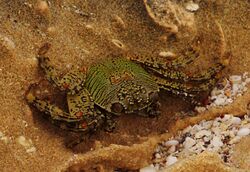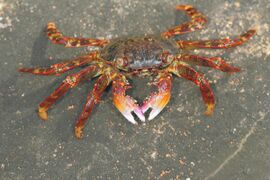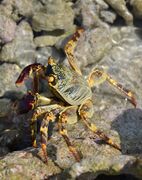Biology:Grapsus albolineatus
| Grapsus albolineatus | |
|---|---|

| |
| Scientific classification | |
| Domain: | Eukaryota |
| Kingdom: | Animalia |
| Phylum: | Arthropoda |
| Class: | Malacostraca |
| Order: | Decapoda |
| Suborder: | Pleocyemata |
| Infraorder: | Brachyura |
| Family: | Grapsidae |
| Genus: | Grapsus |
| Species: | G. albolineatus
|
| Binomial name | |
| Grapsus albolineatus Latreille in Milbert, 1812
| |
| Synonyms | |
| |
Grapsus albolineatus is a species of decapod crustacean in the family Grapsidae, native to the Indo-Pacific.[1]
Description
Its carapace, or upper shell, is flat, circular, and rough with arched lateral margins, and may be up to 37 mm in length. Its chelae, or claws, are short, small, and flattened. Its pereiopods, or legs, are long with a tapered end. The margin of the inferior extremity of its last pair of legs is serrate. Males have bigger claws than females. This species is red, blue, or green in color. Its legs are the same color and have irregular dark-brown mottling.
Habitat and distribution
This species occurs in rocky depths and in coral reefs. It is found in the Indo-Pacific from the East African coast to the Chilean coast.[2][3] This includes the waters of the Red Sea, the Gulf of Aqaba, India, Indonesia, Pakistan, Japan, Australia, and the tropical islands of the Pacific Ocean (such as Hawaii).[4]
Diet
The species consumes a mostly herbivorous diet but also takes small crustaceans and fish.[5]
Reproduction
Like in most other true crabs, light and temperature are the main environmental factors that determine reproductive activity. The female releases her fertilized eggs in its abdomen. This species has a long planktonic larval phase. As the larva matures, it undergoes a series of molts that allow it to grow and reach maturity.
Gallery
References
- ↑ "Catalogue of Life : Grapsus albolineatus Latreille, in Milbert, 1812" (in en). http://www.catalogueoflife.org/annual-checklist/2018/details/species/id/e5db32fe8f61fed85d69c355db6af15a.
- ↑ "Marine Species Identification Portal : Grapsus albolineatus" (in en). http://species-identification.org/species.php?species_group=crabs_of_japan&id=1653.
- ↑ "Sally Lightfoot Crab - Grapsus albolineatus - Maps - Encyclopedia of Life" (in en). http://www.eol.org/pages/342747/maps.
- ↑ "Marine Species Identification Portal : Grapsus albolineatus". http://species-identification.org/species.php?species_group=crabs_of_japan&id=1653.
- ↑ Kennish, R; Williams, GA (1997). "Feeding preferences of the herbivorous crab Grapsus albolineatus:the differential influence of algal nutrient content and morphology". Marine Ecology Progress Series 147: 87–95. doi:10.3354/meps147087. ISSN 0171-8630. Bibcode: 1997MEPS..147...87K. http://hub.hku.hk/handle/10722/57250.
Wikidata ☰ Q6495491 entry
 |




